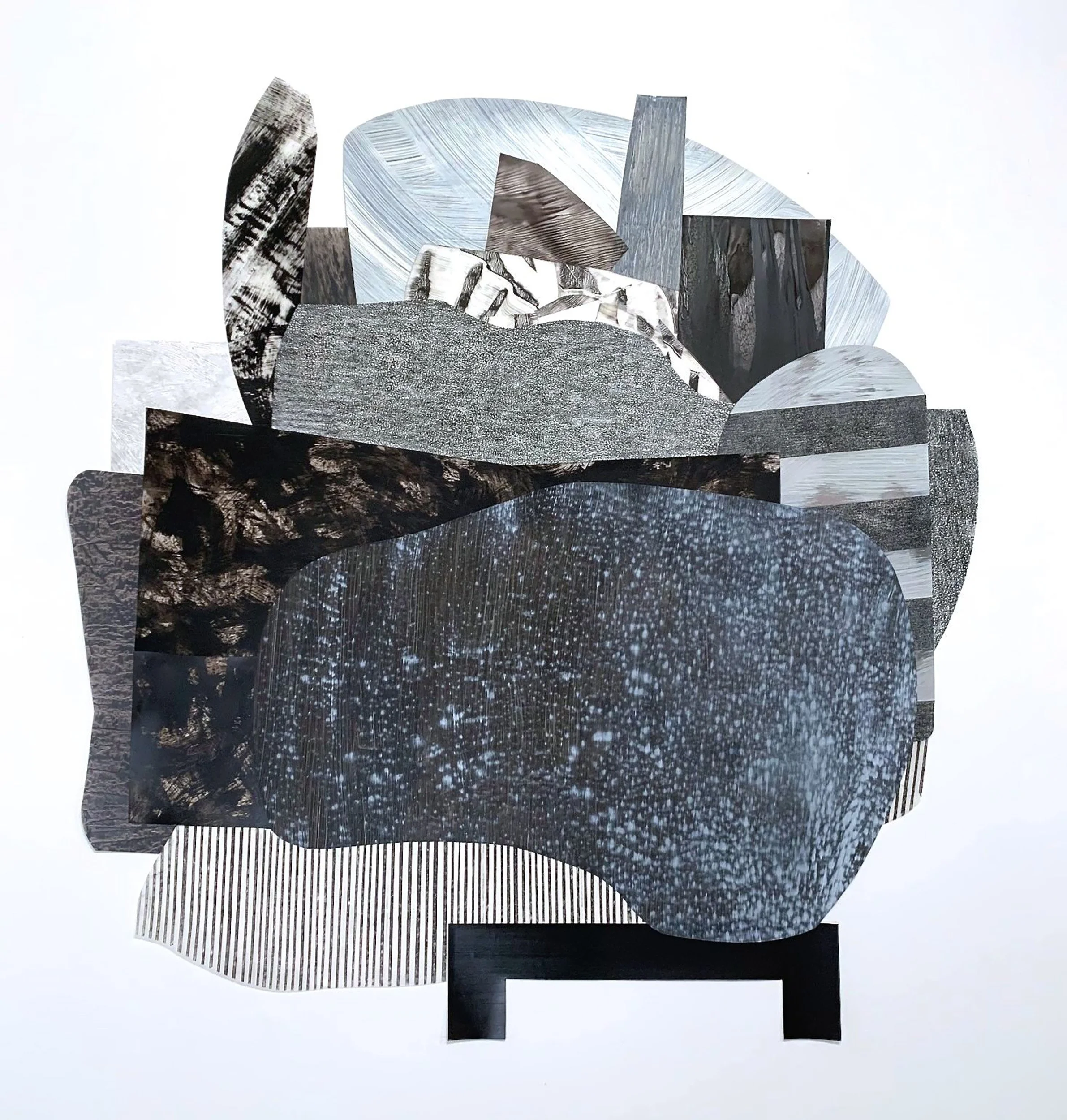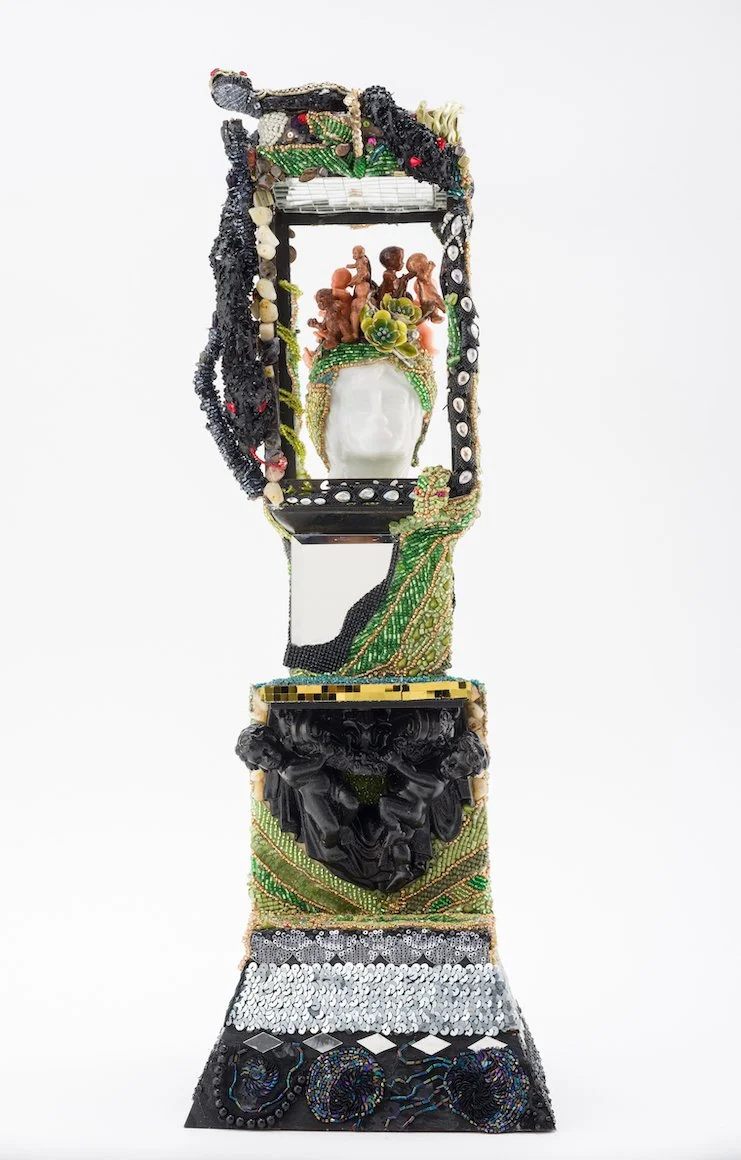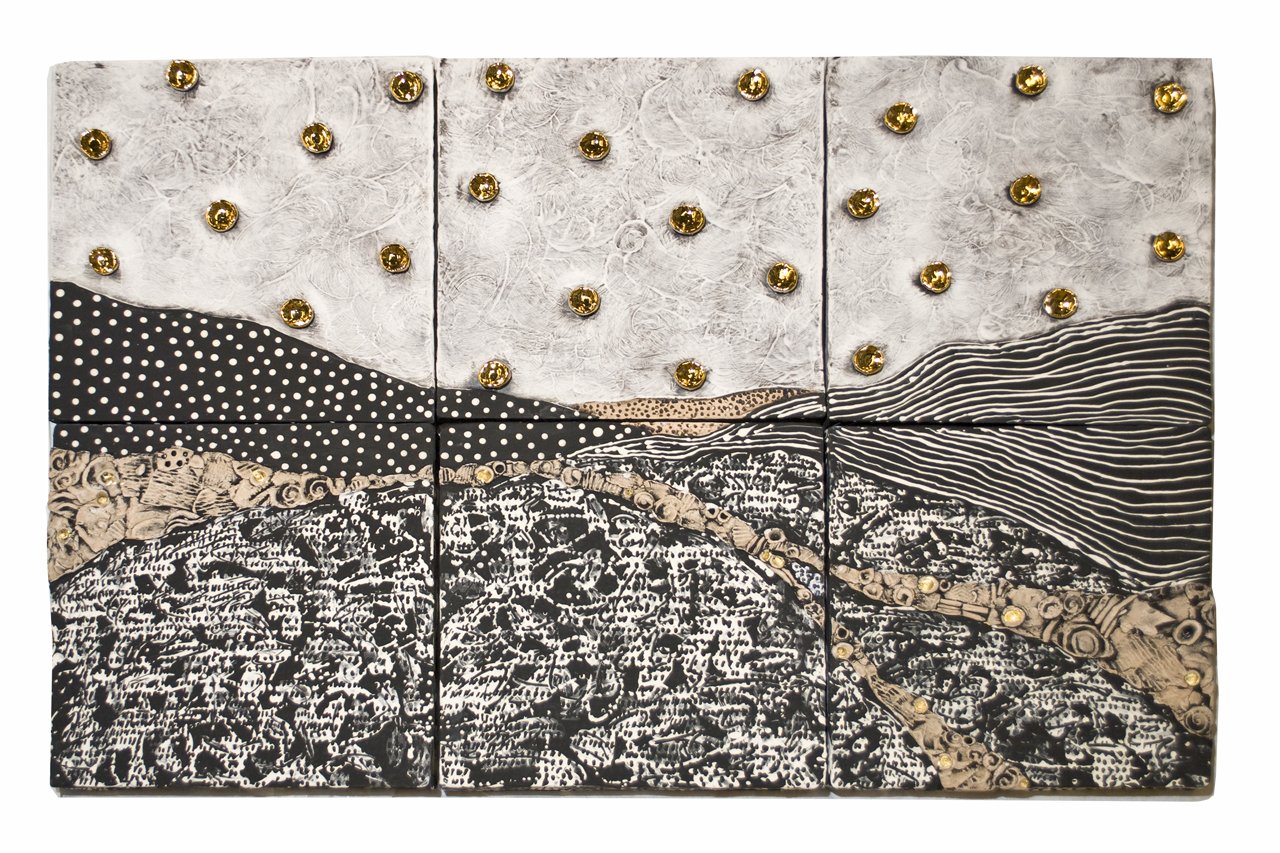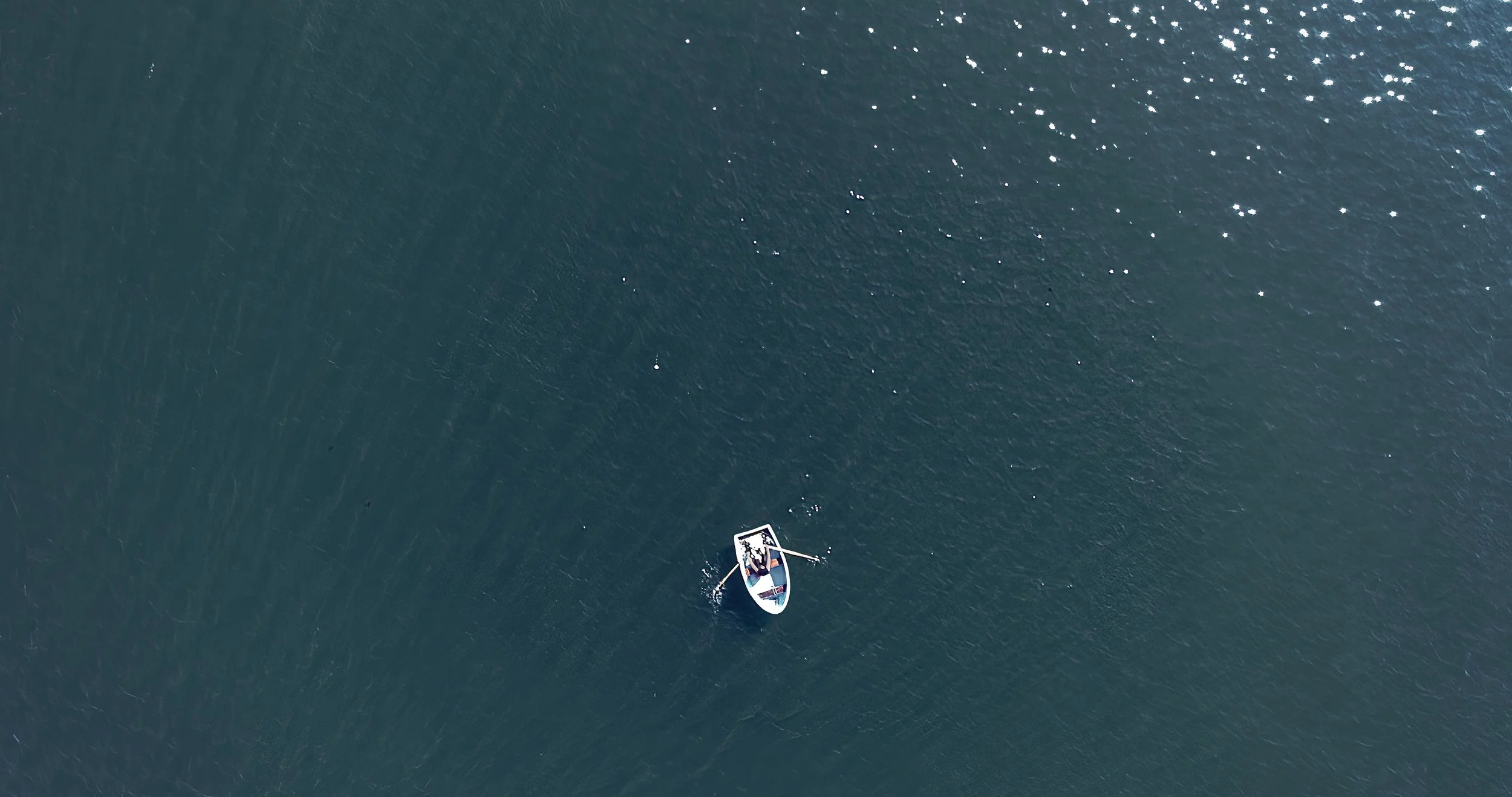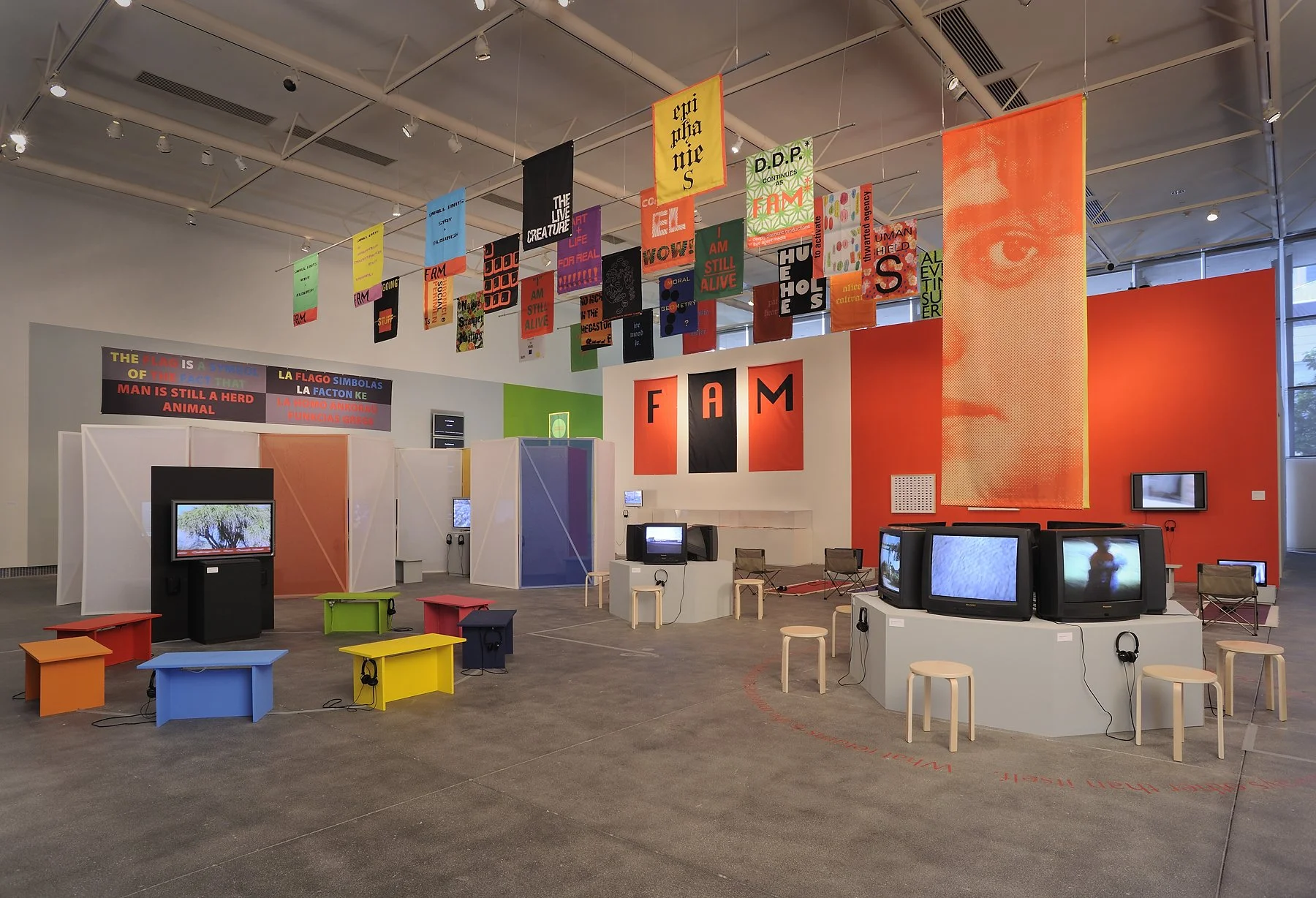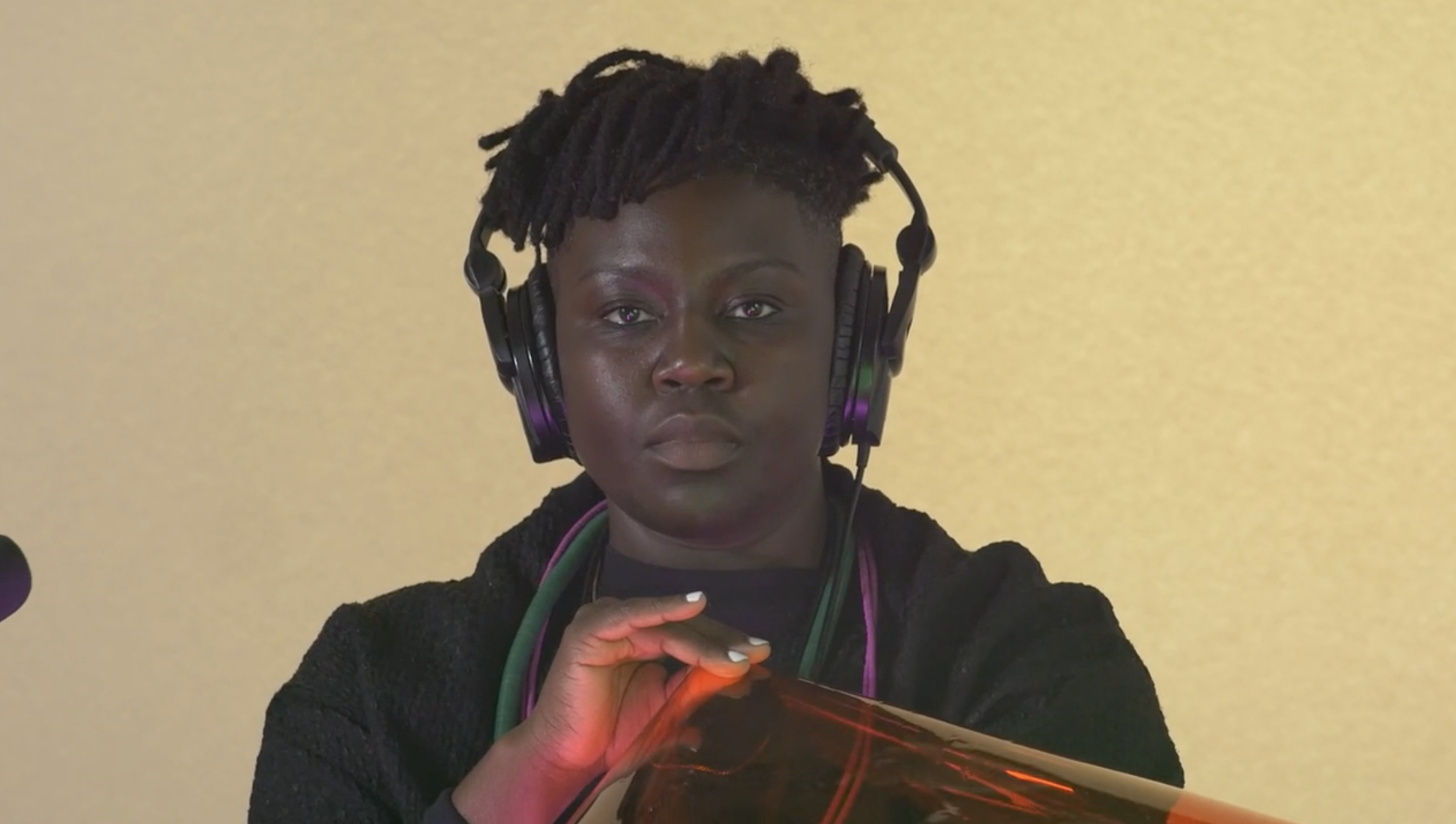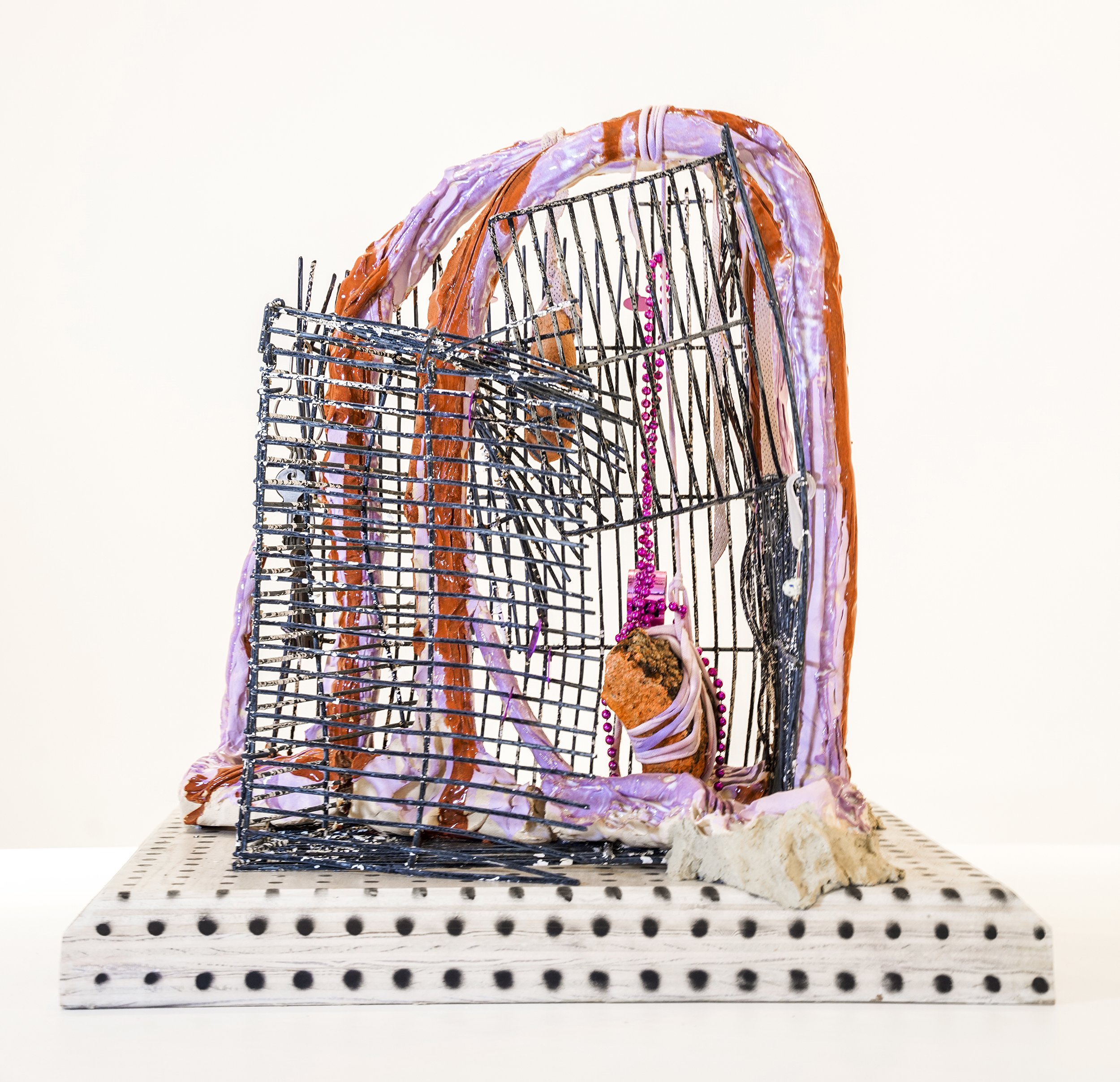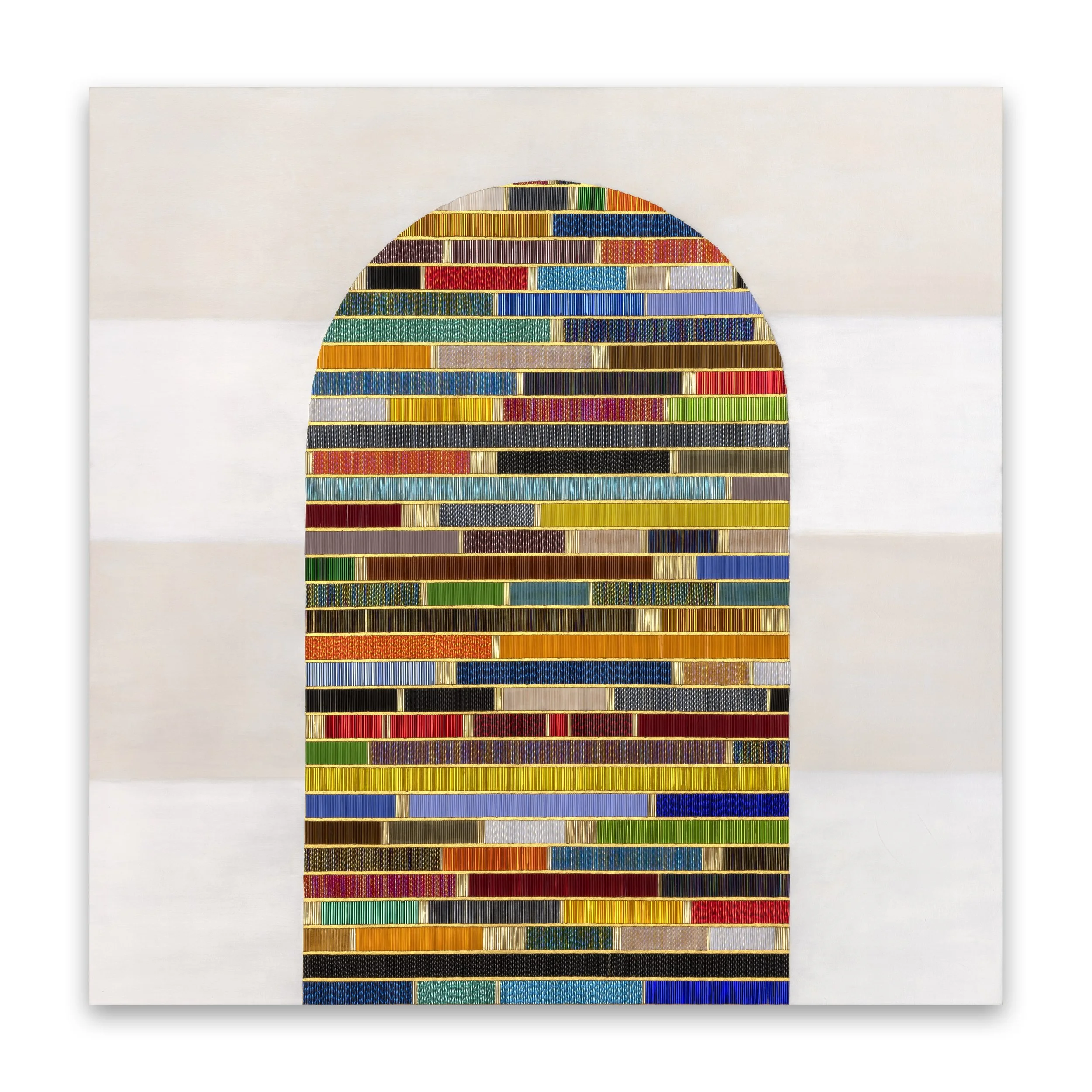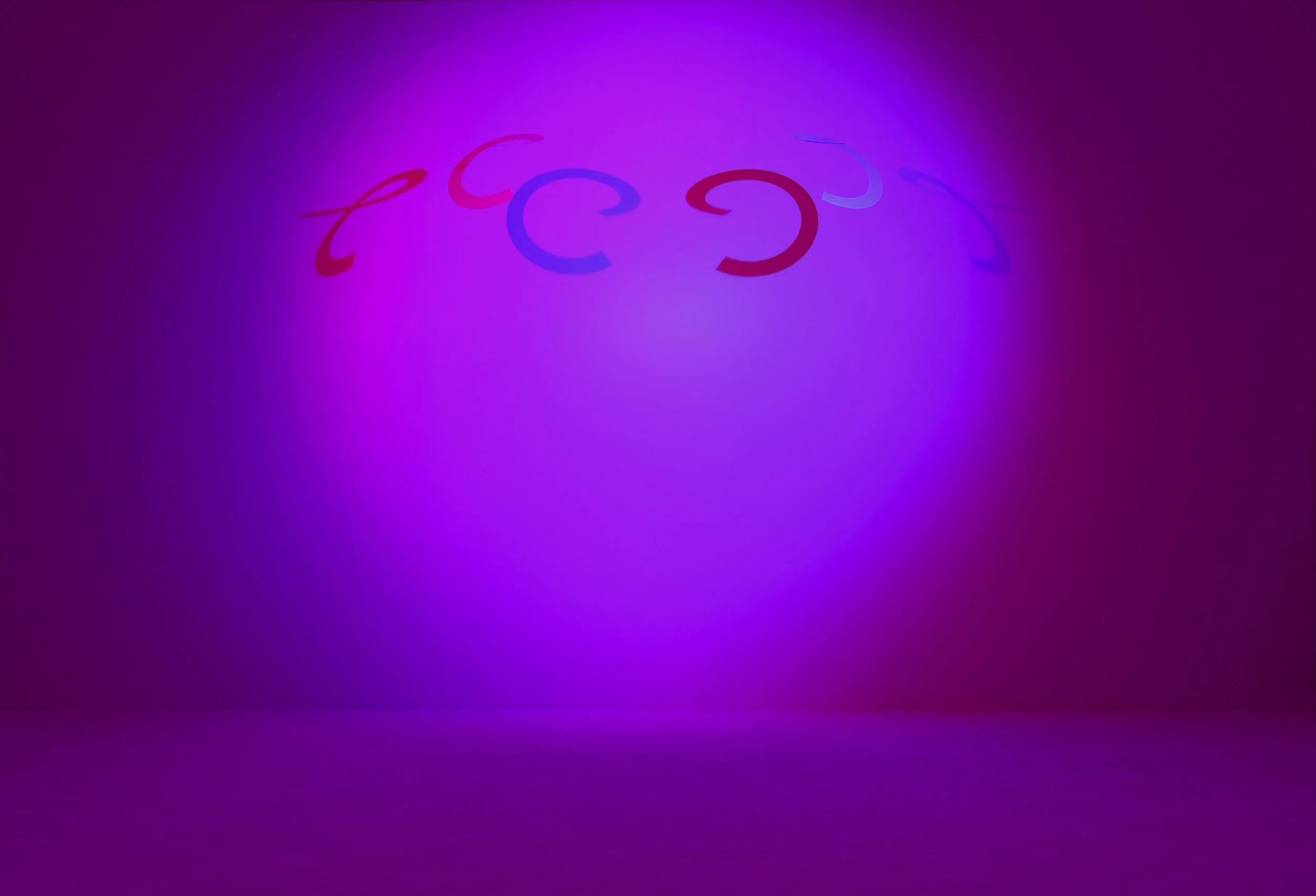While AWAW typically recognizes ten artists per year, donations from two generous supporters have enabled the organization to recognize four additional artists per year in 2021, 2022, and 2023. Three additional awards per year are made possible by the Meraki Artist Award, a new initiative funded by a Boston-based philanthropist who wishes to remain anonymous at this time; one additional award is made possible by an anonymous donor.
Nanette Carter
Nanette Carter (b. 1954, Columbus, OH) is known for her abstract paintings on sheaths of frosted Mylar. CIntangible ideas around contemporary issues are the motivating force for her art. Her works are in the permanent collections of Columbus Museum of Art, OH; Museo Nacional de Bellas Artes, Habana, Cuba; The Pennsylvania Academy of Arts, PA; Perez Art Museum, FL; Saint Louis Art Museum, MO; The Studio Museum in Harlem, NY; and Yale University Art Gallery, CT. Carter’s works have been exhibited across the U.S. and internationally in Damascus and Aleppo, Syria; Kyoto and Osaka, Japan; Habana, Cuba; Perugia, Italy; Lome, Togo; London, England; Sao Paulo, Brazil; and Hamilton, Bermuda. She has received numerous grants that include National Endowment for the Arts, Jerome Foundation, Gottlieb Foundation, The Pollock-Krasner Foundation, New York Foundation for the Arts, and The Mayer Foundation. She is an Emeritus Tenured Associate Professor at Pratt in Brooklyn. She received her BA from Oberlin College, Ohio, and studied abroad her junior year at the Accademia Belle Arte, Perugia, Italy. Her MFA was from Pratt Institute of Art. Carter lives and works in New York.
Image: Cantilevered #58, 2020, 47" x 45”, oil on Mylar
Oletha DeVane
Oletha DeVane (b. 1950, Baltimore, MD) is a multidisciplinary artist who explores political narratives, social identities and cultural interpretations. Her work is in permanent museum collections at the Baltimore Museum of Art and the Reginald F. Lewis Museum, and she is the recipient of numerous awards, grants and commissions. In 2022, the artist will unveil two monument projects: “The Memorial to Those Enslaved and Freed” in Owings Mills, MD, and a public art memorial in Baltimore’s Lexington Market. Her familial and ancestral ties in Maryland, North Carolina, and the Caribbean influence a visual language imbued with Black culture and spirituality, while her social practice and residency engagements range from culturally diverse countries like Haiti, South Africa, Abu Dhabi, Italy, the EU, Israel and Thailand. Through the lens of these experiences, she calls upon a wide variety of mediums such as wood, glass, paint, beads, clay, found objects and video to reimagine the spiritual memory that came from Africa to the Americas. The artist states that, “in connecting to our past, places and cultures, I’m interested in repairing our fragile human kinships and want to encourage the oneness we share.” The work centers on the subliminal, fantastic realities of myth and memory, evoking a sense of awe from that which is familiar.
Image: Woman Who Married a Snake, 2017, Fabric, sequins .glass, beads, wood, pebbles, 26” x9”x 9”
Adama Delphine Fawundu
Adama Delphine Fawundu (b. 1971, Brooklyn, NY) is a photographer and visual artist of Mende and Bubi descent. Her distinct visual language centered around themes of decolonization, and ancestral memory, enrichens and expands the photographic canon. Fawundu co-published the critically acclaimed book MFON: Women Photographers of the African Diaspora. For decades, she has exhibited both nationally and internationally. Her awards include a New York Foundation for The Arts Photography Fellowship (2016) and the Rema Hort Mann Artist Grant (2018), among others, and she is a 2022 Outwin Boochever Portrait Competition finalist. Fawundu was commissioned by the Park Avenue Armory to participate in the 100 Years | 100 Women Project / The Women’s Suffrage NYC Centennial Consortium (2019–2021). Her works are in the permanent collections of the Brooklyn Museum of Art; Princeton University Museum;, Bryn Mawr College; The Petrucci Family Foundation of African American Art, Asbury, NJ; The Brooklyn Historical Society; Norton Museum of Art, Palm Beach; The David C. Driskell Art Collection, College Park, MD; and number of private collections. She is an Assistant Professor of Visual Arts at Columbia University.
Image: Passageways #1, Secrets, Traditions, Spoken and Unspoken Truths or Not, 2017, Archival Pigment on Cotton Rag Photo Paper, 30 x 40 in.
Anita Fields
Anita Fields (b. 1951, Oklahoma) is a contemporary Native American multi-disciplinary artist of Osage heritage. She is known for works that combine clay and textile with Osage knowledge systems. Fields explores the intricacies of cultural influences at the intersections of balance and chaos found within our existence, including early Osage concepts of duality, such as earth and sky, male and female. Her sculptures have been featured in many solo and group exhibitions, including Weaving History Into Art; The Enduring Legacy of Shan Goshorn at the Gilcrease Museum (2020–21), Form and Relation: Contemporary Native Ceramics, the Hood Museum, Dartmouth College (2020–2021), Hearts of Our People at the Minneapolis Institute of Art (2018–2019), and A rt for A New Understanding: Native Voices, 1950’s to Now (2018) at the Crystal Bridges Museum of American Art. Her work was also included in Who Stole the Teepee? at the National Museum of the American Indian, Smithsonian, New York (2000), and Legacy of Generations: Pottery by American Indian Women at the National Museum of Women in the Arts, Washington, D.C. (1997).She has been published in Ms. Magazine, American Craft, and Southwest Art Magazine. Her work can be collections including the Museum of the American Indian, Smithsonian, Washington, D.C.; the Museum of Art and Design, New York; the Minneapolis Institute of Art;, the Crystal Bridges Museum of American Art, Bentonville, AR; the Hood Museum, Dartmouth College, Hanover, NH; and the Heard Museum, Phoenix. Fields was a 2017o2019 fellow with the Kaiser Foundation Tulsa Artist Fellowship program and is currently a 2020–-2021 Tulsa Artist Fellowship Integrated Arts Grant awardee. She is the invited artist for the 2021 Eiteljorg Museum of Contemporary Art Fellowship and was recently named a 2021 National Endowment of the Arts Heritage Fellow.
Image: Movement of the Sun II, 2011, Clay, slips, gold luster glaze, 21” x 32” x 1 ½”
Wall installation representing the cultural memory found within the terrain of Indigenous original homelands and sacred places. The daily path of the sun over the earth represents Osage beliefs and knowledge systems.
Coco Fusco
Coco Fusco (b. 1960, New York City, NY) is an interdisciplinary artist and writer. She is a recipient of numerous awards, including a Guggenheim fellowship, an American Academy of Arts and Letters Award, a Fulbright fellowship and a Herb Alpert Award in the Arts. Fusco’s performances and videos have been presented in the 56th Venice Biennale, Frieze Special Projects, Basel Unlimited, two Whitney Biennials (2008 and 1993), and several other international exhibitions. Her works are in the permanent collections of the Museum of Modern Art, The Walker Art Center, the Centre Pompidou, the Imperial War Museum, and the Museum of Contemporary Art of Barcelona. She is the author of Dangerous Moves: Performance and Politics in Cuba (2015). She is a Professor of Art at Cooper Union. Fusco is currently preparing new works for the next Sharjah Biennial and a solo retrospective that will open in 2023.
Image: Your Eyes Will Be an Empty Word, 2021, Video, 12 minutes
Renée Green
Renée Green (born 1959, Cleveland, OH) is an artist, writer, and filmmaker known for her highly layered and formally complex multimedia installations in which ideas, perception, and experience are examined from myriad perspectives. Green’s exhibitions, videos and films have been presented throughout the world in museums and art institutions, among them the Carpenter Center for Visual Arts at Harvard University; MAK Center for Art + Architecture at the Schindler House, West Hollywood; and the Museum of Modern Art, the Whitney Museum of American Art, and the New Museum, all in New York, as well as many others. Extensive surveys of her work have been organized by the Musée cantonal des Beaux Arts, Lausanne, Switzerland (2009), Yerba Buena Center for Visual Arts, San Francisco (2010), and KW Institute for Contemporary Art and daadgalerie, Berlin (2021). Green’s most recent books include Pacing (2020, CCVA, FAM, Cambridge, Mass.), Other Planes of There: Selected Writings (2014, Duke University Press, Durham), Endless Dreams and Time-Based Streams (2010, Yerba Buena Center for the Arts, San Francisco), and Ongoing Becomings (2009, Musée cantonal des Beaux-Arts, Lausanne). She is also the editor of the collection of essays Negotiations in the Contact Zone (2003, Assírio & Alvim, Lisbon) and a Professor at the MIT’s Art, Culture, and Technology Program, School of Architecture & Planning.
Image: Endless Dreams and Time-Based Streams, 2010. Installation view. Yerba Buena Center for the Arts, San Francisco. Image: Phocasso / J.W. White
All images courtesy of the artist and Free Agent Media
Judithe Hernández
Judithe Hernández (b. 1948, Los Angeles, CA) earned her BFA and MFA at Otis Art Institute. Her public art and studio practice have been dedicated to the social-political issues affecting Mexican Americans and the empowerment of Latinas. In the 1970s, as a founding member of the Chicano Art Movement, she received acclaim as a muralist during the Los Angeles Mural Renaissance. During this period, she was among the first Chicanx artists to break through the mainstream museum barrier when her work was included in major exhibitions at the Oakland Museum of Art, LACMA, the Los Angeles Institute of Contemporary Art, and the San Francisco Museum of Modern Art.
The international significance of her work came in 1989 with the first exhibition of Chicano art in Europe, Les Démon des Anges. The exhibition traveled to major venues in Stockholm, Paris, Lyon, and Barcelona. In 2011 and 2017, the sweeping Getty-sponsored arts initiatives known as “Pacific Standard Time” included her work in multiple exhibitions. Over her 50-year career, she has established a significant record of exhibition and acquisition of her work by major public institutions and private collections which include: the Museum of Modern Art, the Smithsonian American Art Museum, the Pennsylvania Academy of Fine Art, the National Museum of Mexican Art, LACMA, and Bank of America. She has been the recipient of the prestigious University of Chicago Artist-in-Residence at the Center for the Study of Race, Politics, & Culture, and the C.O.L.A. Fellowship awarded by the City of Los Angeles. In 2020, after a 40 year absence, her artistic presence returned to downtown Los Angeles when her seven-story mural “La Nueva Reina de Los Angeles” was installed in the El Pueblo de Los Angeles Historical Monument District.
Image: The Journey to Heaven’s Western Gate, 2020, Pastel on paper, 44 x 60”
Suzanne Jackson
Suzanne Jackson (b. 1944, St. Louis, MO) works in Savannah, Georgia, where she has lived since 1996. Her recent works are highly abstracted “anti-canvases,” with flexible two-dimensional surfaces realized into three-dimensional form, contrasting with her early figurative paintings. She was the subject of a major retrospective exhibition and monograph, Five Decades, organized by the Jepson Center for the Arts, Telfair Museums, Savannah (2019). She has presented solo exhibitions at Ortuzar Projects, New York; O-Town House, Los Angeles; Danville Museum of Fine Arts, Danville, Virginia;, and Fashion Moda, New York. Her work has featured in institutional surveys and historic exhibitions including Life Model: Charles White and His Students, Los Angeles County Museum of Art (2019); West by Midwest, Museum of Contemporary Art, Chicago (2018–19); Soul of a Nation: Art in the Age of Black Power, Brooklyn Museum, New York (2018–19); Now Dig This! Art and Black Los Angeles 1960–1980, Hammer Museum, Los Angeles (2011–13); Gallery 32 & Its Circle, Laband Art Gallery, Loyola Marymount University, Los Angeles (2009); Synthesis, Just Above Midtown Gallery, New York (1974); Directions in Afro American Art, Herbert F. Johnson Museum of Art, Cornell University, Ithaca (1974); and Black Mirror, Womanspace Gallery, Los Angeles (1973). From 1969–1970 she ran the influential Gallery 32 from her studio in Los Angeles, which in 1970 presented the first group exhibition of Black women artists in L.A. and, likely, the U.S. She is a recipient of the NYFA Murray Reich Distinguished Artist Award (2020) and a Joan Mitchell Foundation Painters & Sculptors Grant (2019). Her work is in the permanent collections of The Art Institute of Chicago; The Baltimore Museum of Art; The California African American Museum; The Indianapolis Museum of Art, Newfields; The Museum of African American Art, Los Angeles; and the Museum of Modern Art, New York.
Image: “Rag-to-Wobble”, 2020, Acrylic, cotton paint cloth, vintage dress hangers, 86 x 63 with 14-inch variable bulge (218.4 x 160 with 35.6 cm)
Photo by David Kaminsky. Courtesy of the artist and Ortuzar Projects New York City
Autumn Knight
Autumn Knight (b. 1980, Houston, TX) is an interdisciplinary artist working with performance, installation, video, and text. Knight makes performances that reshape perceptions of authority figures, power dynamics, and audience expectations of live experiences. Her video and performance work have been viewed within several institutions including the The New Museum (New York), Human Resources (Los Angeles), Western Front, (Vancouver, Canada), Akademie der Kunste (Berlin), On the Boards (Seattle), and the Whitney Museum of American Art and The Kitchen (New York). Her performance and video work is held in the permanent collection of the Studio Museum in Harlem. She is the recipient of several awards and grants including Artadia, Art Matters, Rema Hort Mann, and the Smithsonian Artist Research Fellowship, and is a recent recipient of The Nancy B. Negley Rome Prize. She lives and works in New York.
Image: Autumn Knight for Western Front, 2021
Photo Credit: Autumn Knight
Adia Millett
Adia Millett (b. 1975, Pasadena, CA) makes art that honors the history of domestic craft, abstraction, and architecture, while being inspired by Afrofuturism, emotional resilience, and the preservation of our land. Her work ranges from painting, quilting, stained-glass, collage, video, and sculpture, to installation. Investigating the fragile interconnectivity among all living things, she deconstructs images, ideas, and materials to shed light on the multifaceted and complex parallels between the creative process and the nature of personal identity. Millett received her BFA from the University of California, Berkeley, and an MFA from the California Institute of Arts. She was an artist-in-Residence at the Whitney Museum Independent Study Program and the Studio Museum in Harlem. She has exhibited at prominent institutions including the New Museum, New York; P.S. 1, New York; Museum of the African Diaspora, San Francisco; Oakland Museum; Crocker Art Museum, Sacramento; Yerba Buena Center for the Arts, San Francisco; Santa Monica Museum of Art; The Museum of Contemporary Art, Atlanta; The Contemporary Art Center, New Orleans; Barbican Gallery, London, San Jose Quilt and Textile Museum; and at the California African American Museum, Los Angeles, which hosted a critically acclaimed solo exhibition of her work in 2019. Millett has taught at Columbia College in Chicago, UC Santa Cruz, Cooper Union in New York, and California College of the Arts. Millett currently lives and works in Oakland, California.
Image: Underground
Anna Sew Hoy
Anna Sew Hoy (b. 1976, Auckland, New Zealand; American) utilizes sculpture, ceramics, public art and performance to connect with our environment, and to demonstrate the power found in the fleeting and handmade. Her work has been at the forefront of a re-engagement with clay in contemporary art, and is identified with a critical rethinking of the relationship between art and craft. Sew Hoy’s work is in the collections of the Hammer Museum, the San Francisco Museum of Modern Art, the Los Angeles County Museum of Art, and the Museum of Contemporary Art in San Diego. Solo presentations of Sew Hoy’s work have been mounted at the Aspen Art Museum; the MOCA Storefront, Los Angeles; the Hammer Museum, Los Angeles; Koenig & Clinton, New York; LAXART; Various Small Fires, Los Angeles; the San Jose Museum of Art; and the California Biennial 2008 at the Orange County Museum of Art. In 2018 she was the inaugural Martha Longenecker Roth Distinguished Artist in Residence at UC San Diego Department of Visual Arts. She was awarded a Creative Capital Grant for Visual Art in 2015 to support her public sculpture Psychic Body Grotto. She was awarded the California Community Foundation Grant for Emerging Artists in 2013, and the United States Artists Broad Fellowship in 2006. Sew Hoy’s largest public sculpture to date, Psychic Body Grotto opened at the Los Angeles State Historic Park in Spring 2017. She is Associate Professor and Ceramics Area Head at University of California, Los Angeles.
Image: Somebody’s Head
Julie Tolentino
Julie Tolentino (Filipino-Salvadorean, b. 1964) is an interdisciplinary artist invested in performance installation, object-making, video, and texts. Her work has been shown at The New Museum, Aspen Art Museum, Nevada Art Museum, Thessaloniki Biennial, Performance Space New York, The Kitchen, Participant, Inc. (NY); Los Angeles Contemporary Exhibitions, Commonwealth and Council (Los Angeles); The Lab (San Francisco). Projects include Visual AIDS Duets Book series with Kia LaBeija; Movements in Blue with the What Would An HIV Doula Do? Collective; and Safer Sex Handbook with Cynthia Madansky. Tolentino initiated and ran the Clit Club (with Jaguar Mary until 1991 and with a dedicated crew until 2002.) She is the senior editor for the Provocations in The Drama Review (TDR) since 2012. Tolentino received her MFA as the University of California at Riverside’s Dean’s Distinguished Fellow in Experimental Choreography in 2020. She received a Herb Alpert/UCROSS Residency Prize (2021); Queer|Art Sustained Artist Recognition (2020); Herb Alpert/MacDowell Fellowship, Foundation for Contemporary Art - Performance Grant (2019). Tolentino is the current 2021-2022 Scholar-in-Residence at NYU Steinhardt; the Alma Hawkins Chair in the World Arts & Cultures Department at UCLA, Winter 2022, and a 2022-2023 Queer|Art Mentor. Tolentino is an artist/maker/contributor with Commonwealth and Council, Los Angeles.
Image: Cry of Love - Honey. Haus Der Kulturen der Welt, Berlin, Germany. Photo by G. Golpke
Dyani White Hawk
Dyani White Hawk (Sičáŋǧu Lakota, b.1976, Madison, WI) is a multimedia artist and independent curator based in Minneapolis, Minnesota. Through painting, beadwork, installation, performance, and curation, her practice challenges the lack of representation of Native arts, people, and voices in our national consciousness while highlighting the truth and necessity of intersectionality and relatedness across life. White Hawk has received numerous awards, including an Arts and Letters Award in Art (2021), McKnight Visual Artist Fellowship (2021 and 2014), United States Artists Fellowship in Visual Art (2019), Eiteljorg Fellowship for Contemporary Art (2019), Jerome Hill Artists Fellowship (2019), Native Arts and Cultures Foundation Fellowship (2017 and 2015), and the Joan Mitchell Foundation Painters and Sculptors Grant (2014). She has participated in residencies in New Orleans, Santa Fe, Australia, Russia, and Germany. A major ten-year survey exhibition of her practice, Speaking to Relatives, opened at the Kemper Museum of Contemporary Art in 2021, and travels to the Museum of Contemporary Art Denver in 2022. Her work is in numerous collections including the Akta Lakota Museum, Crystal Bridges Museum of American Art, Denver Art Museum, Minneapolis Institute of Art, Museum of Fine Arts, Boston, Museum of Modern Art, New York, the Pennsylvania Academy of the Fine Arts, Portland Art Museum, Saint Louis Art Museum, Smithsonian National Museum of the American Indian and the Walker Art Center. White Hawk earned her MFA from the University of Wisconsin-Madison and BFA from the Institute of American Indian Arts. She will begin an appointment as Assistant Professor in the Department of Art for the University of Wisconsin-Madison, beginning fall of 2022.
Image: Untitled (All the Colors), 2020, acrylic, glass bugle beads, sinew on canvas, 48 x 48 in.
Marian Zazeela
Marian Zazeela (b. 1940, New York, NY) is one of the first contemporary artists to use light as a medium of expression, and perhaps the first to compose recurring motivic and thematic statements and permutations with light over time as in music. Over more than five decades, Zazeela has exhibited a unique iconographic vision in media encompassing painting, calligraphic drawing, graphics, film, light performance, sculpture and environment. As a founding member and artistic director of The Theatre of Eternal Music and The Just Alap Raga Ensemble, in which she collaborates with composer La Monte Young, she performed as vocalist and created the works that form the innovative visual components of Dream House. Zazeela’s work has been significantly influential. Her abstract calligraphy was the primary influence on the calligraphy of the great poet and founding drummer of The Theatre of Eternal Music and the Velvet Underground, Angus MacLise. The visionary tradition of her curvilinear graphite on black and dot-style calligraphic drawings has also been carried on and taken to a highly imaginative level in the pencil and pinhole drawings of her disciple, Jung Hee Choi. Zazeela’s Ornamental Lightyears Tracery has been credited by Glenn Branca in Forced Exposure #16, 1990, and by David Sprague in Your Flesh #28, 1993, to have been the direct influence on Warhol’s Exploding Plastic Inevitable.
Image: Marian Zazeela, Primary Light (Red/Blue), 1990, Light Environment installation at Dream House: Centre Pompidou-Metz, France; 2018. Photo: Jung Hee Choi.

